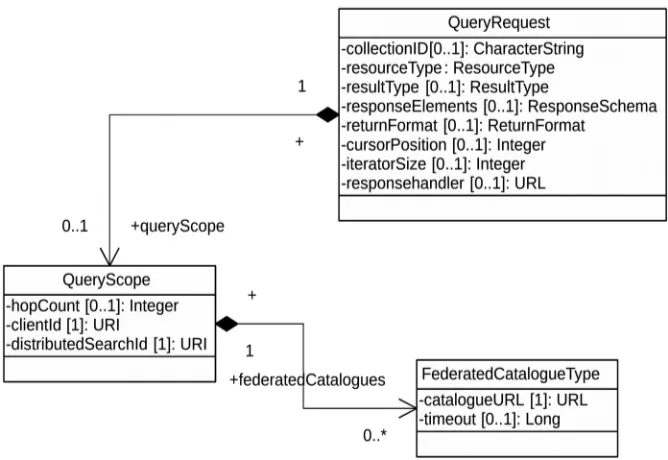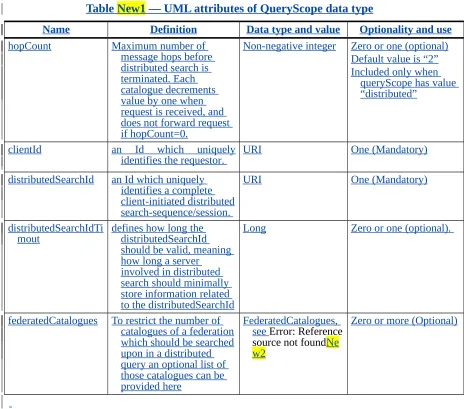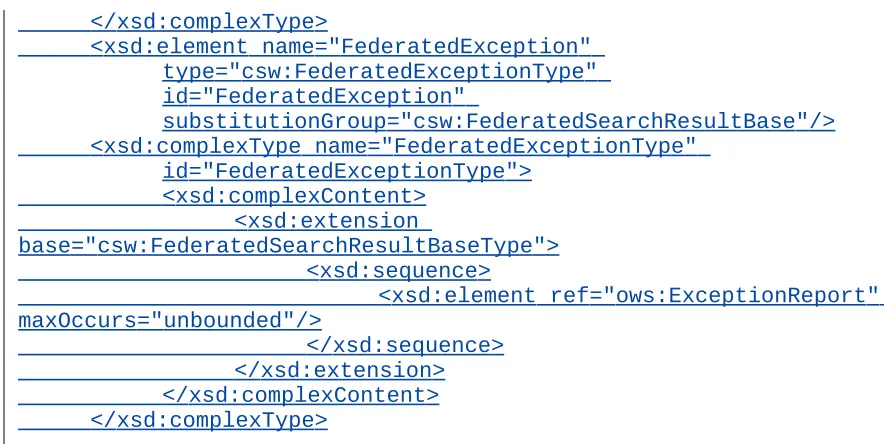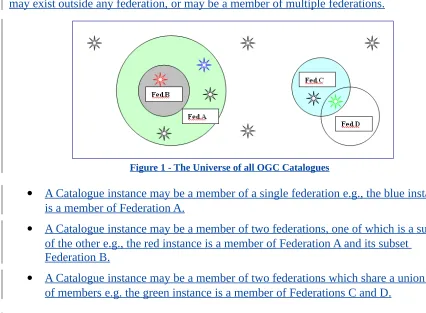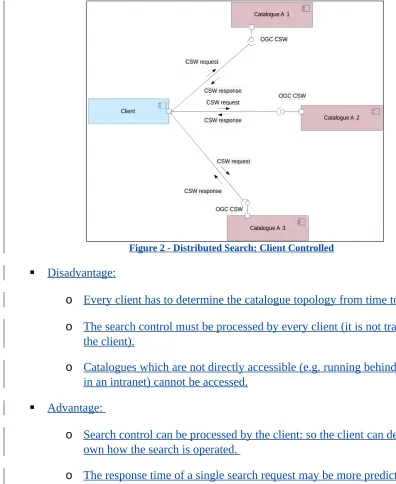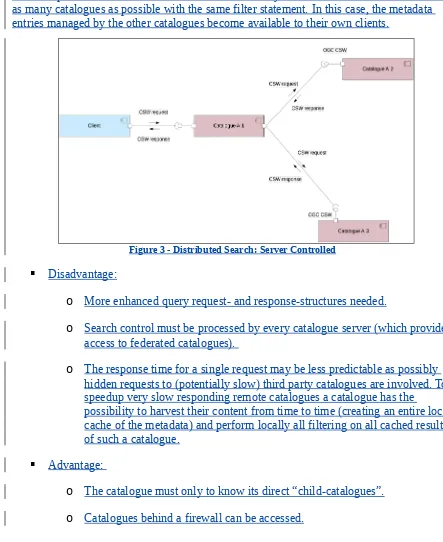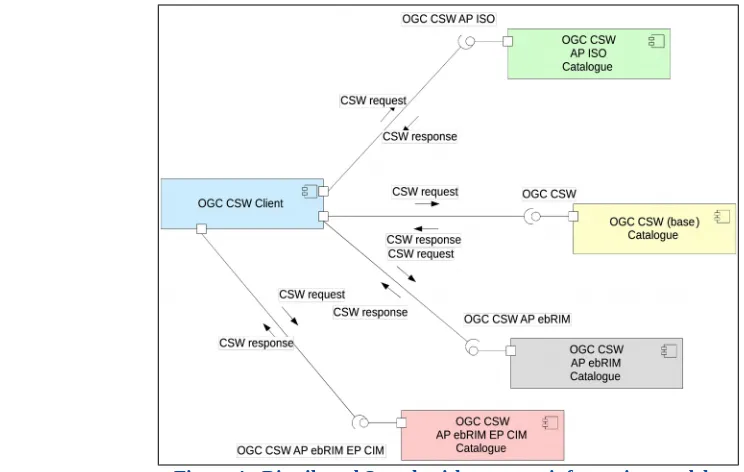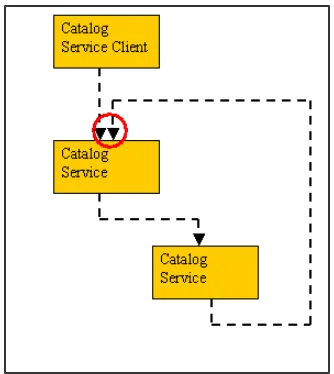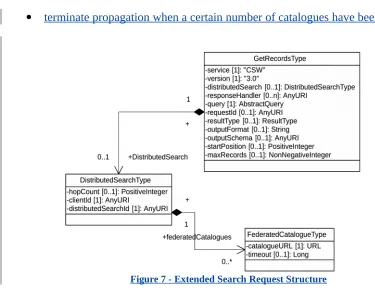CR-Form-v3
CHANGE REQUEST
CS 2.0.2 CR ?
rev-
Current version: 07-006r1 For HELP
on using this form, see bottom of this page or look at the pop-up text over the symbols. Proposed change affects: AS Imp Spec X Best Practices Paper Other Title: Distributed Search Change request – affects different chapters of the spec
Source: Uwe Voges, Dieter Stüken, Udo Einspanier (con terra GmbH), Bruce Westcott (Intergraph), Mike Power (Powerscourt)
Work item code: Date: 2008-10-1520
Category: C
Use one of the following categories: F (Critical correction)
A (corresponds to a correction in an earlier release) B (Addition of feature),
C (Functional modification of feature) D (Editorial modification)
Detailed explanations of the above categories can be found in the TC Policies and Procedures.
Reason for change: Often not clear to the reader how distributed search works (alternatives of distributed search and possible problems). There exist also some problems with the current specification and some capabilities are missing.
Summary of change: Improvement of definition what distributed search is, which alternatives for distributed search are available and what problems can arise. Functional extensions to the discovery request and response messages (which define elements that allow for the retrieval and comprehension of a distributed result set).
Consequences if
not approved:
Reduced capabilities, actual specification can cause problems: the whole distributed system can potentially fail within a distributed search, duplication of results, client must search all catalogues at any time within a distributed search, no error messages (if some) raised by connected catalogues available to the client, no information which catalogues provides which results, no runtime information,…
Clauses affected: General Model Part: 7.2.4.2, Fig. 5, Table 10
HTTP Protocol Binding Part: 6.8.2, 6.8.3, 6.8.4.13, 6.8.5, 6.8.6, 6.9.1, Annex B, table 15,16
Affected: Abstract specifications Best Practices Document Supporting Doc.
Other comments: This change request is written as changes to OGC 07-006 General Model Part and HTTP Protocol Binding Part
Status
Edit Figure 5 in General Model:
Add the QueryScope- and the FederatedCatalogueType-classes and change the attributes of the QueryRequest as follows (leave the rest of the diagram in figure 5 as it is):
Edit Table 10 in General Model as follows:
Name Definition Data type and value Optionality and use sessionInfo The core set of parameters
required in each message exchanged between a client and server operating in a session context, where and/or result sets are persistent
queryExpression The query language and predicate expressing query
collectionID Specifies the search space for this query. Search space can be all catalogue holdings, a previously named result set, or a named subspace of the catalogue holdings
resourceType A catalogue may contain references to several different resource types. This parameter provides for the selection of one of those types for processing
CodeList type a One (Mandatory)
queryScope Scope of this query. QueryScope, see
Table New1 Zero or one (optional).Zero means “local” search
queryScope Scope of this query. CodeList type with allowed values of “local” and “distributed”
Zero or one (Optional) Default value is “local”
hopCount Maximum number of
message hops before distributed search is terminated. Each catalogue decrements value by one when request is received, and does not forward request if hopCount=0.
Non-negative integer Zero or one (optional) Default value is “2” Included only when
queryScope has value “distributed”
Name Definition Data type and value Optionality and use ResponseElements
C Specifies set name or list of metadata elements to be returned in the context of a specific metadata structure
ResponseSchema C The name of the “well-known” or advertised (in the capabilities) schema of the response
Code List type with one mandatory
Zero or one (Optional). If the parameter is not specified then the default value is “OGCCORE”.
sortSpec Sorting information to the server for formatting data returned to the client
SortSpec, See Error: Reference source not found
Zero or one (Optional) Default is sorted on ID
in descending order
returnFormat Specifies format (MIME or Internet media type) for returning result set Include when results to
be returned cursorPosition First result set resource to be
returned for this operation request
Positive integer Zero or one (Optional) Default is “1”
Include when results to be returned
iteratorSize Specifies maximum number of result set resources to be returned
Non-negative integer Zero or one (Optional) Default is “10”
Include when results to be returned
responseHandler Network location to which the response will be forwarded when operation has been completed, for asynchronous requests
URL Zero or one (Optional)
If not included, process request synchronously
a Values and definitions of resourceType codes:
Data set – the lowest level packaging of Features that have been catalogued
Name Definition Data type and value Optionality and use
b Values and definition of resultType codes and behaviours in session based environments:
validate - the QueryResponse is returned as soon as QueryRequest has been determined to be valid. Query processing continues after the QueryResponse is returned.. Reasons for failure are provided in the diagnostic of QueryResponse.
resultSetID - the QueryResponse is returned as soon as the resultSetID is available and the query has completed processing.
hits- the QueryResponse is returned as soon as the query has completed processing and the number of hits has been determined. Metadata records are not returned in the QueryResponse
results - the QueryResponse is returned as soon as the query has completed processing and the results have been formatted for return. Metadata records are returned in the QueryResponse
c The information model of this specification is the core catalogue schema defined in Subclause 6.3. It represents the common part of the information model which all application profiles shall support. This
specification only supports 'OGCCORE' as the value of the 'responseSchema' parameter and a value of “brief”, “summary” or “full” for the value of the ‘responseElements’ parameter. Additional values for the
responseSchema and responseElements parameters may be defined by application profiles.
Table New1 — UML attributes of QueryScope data type
Name Definition Data type and value Optionality and use
hopCount Maximum number of
message hops before distributed search is terminated. Each catalogue decrements value by one when request is received, and does not forward request if hopCount=0.
Non-negative integer Zero or one (optional) Default value is “2” Included only when
queryScope has value “distributed”
clientId an Id which uniquely
identifies the requestor. URI One (Mandatory) distributedSearchId an Id which uniquely
identifies a complete client-initiated distributed search-sequence/session.
URI One (Mandatory)
distributedSearchIdTi
mout defines how long the distributedSearchId should be valid, meaning how long a server involved in distributed search should minimally store information related to the distributedSearchId
Long Zero or one (optional).
Table New2 — UML attributes of FederatedCatalogueType data type
Name Definition Data type and value Optionality and use catalogueURL a catalogue is represented
by it’s url. URL One (Mandatory)
timeout timeout (in msec) how long a server should wait for a catalogue request to be
proceeded before
throwing a timeout exception
Long One (Mandatory)
Edit Table 15 of the HTTP Protocol Binding as follows:
Table 2 — KVP encoding for GetRecords operation requestKeyword d Data type and value Optionality and use Parameter in
general model
REQUEST Character String
Fixed value of GetRecords, case insensitive
One (Mandatory) a (none)
service Character String
Fixed values of “CSW”
One (Mandatory) serviceId
version Character String
Fixed value of 2.0.2
One (Mandatory) (none)
NAMESPACE List of Character String, comma separated
Used to specify a namespace and its prefix
Format shall be
xmlns([prefix=]namespace-url). If the prefix is not specified then this is the default namespace. If not included, all qualified names are in default namespace
(none)
resultType CodeList with allowed values: ”hits”, “results” or ”validate”
requestId URI Zero or one
(Optional) case of a distributed search.
Keyword d Data type and value Optionality and use Parameter in
general model
outputFormat Character String
Value is Mime type
The only value that is required to be supported is application/xml. Other supported values may include text/html and text/plain
Zero or one (Optional) Default value is application/xml
returnFormat
outputSchema Any URI.. Zero or one
(Optional) Default value is http://www.opengis. net/cat/csw/2.0.2.
responseSchema
startPosition Non-Zero Positive Integer Zero or one
(Optional) Default value is 1
cursorPosition
maxRecords Positive Integer Zero or one
(Optional)
Default values is 10
iteratorSize
typeNames List of Character String, comma separated
Unordered List of object types implicated in the query
One (Mandatory) collectionID
ElementSetName List of Character String Zero or one
(Mutually exclusive with ElementName)
responseElements
ElementName List of Character String Zero or more
(Mutually exclusive with
ElementSetName)
responseElements
CONSTRAINTLANGUAGE CodeList with allowed values: CQL_TEXT or FILTER
Zero or one
Predicate expression specified in the language indicated by the CONSTRAINTLANGUAGE parameter
Zero or one (Optional)
Default action is to execute an
unconstrained query
predicate
SortBy List of Character String, comma
separated
Ordered list of names of metadata elements to use for sorting the response
Format of each list item is metadata_element_name:A indicating an ascending sort or metadata_ element_name:D indicating descending sort
Zero or one (Optional)
Default action is to present the records in the order in which they are retrieved
Keyword d Data type and value Optionality and use Parameter in
general model
DistributedSearch Boolean Zero or one
(Optional) Default value is FALSE
queryScope
hHopCount Integer Zero or one
(Optional) Include only if DistributedSearch parameter is included
Default value is 2
hopCountquerySc ope
ClientId Any URI Conditional:
Mandatory if DistributedSearch set to TRUE
clientId
DistributedSearchId Any URI Conditional:
Mandatory if DistributedSearch set to TRUE
distributedSearchI d
DistributedSearchIdTimout This timout parameter defines (in
sec) how long the
distributedSearchId should be valid, meaning how long a server involved in distributed search should minimally store information related to the distributedSearchId
Zero or one (optional). Default value is 600.
distributedSearchI dTimout
FederatedCatalogues List of comma separated structures
of the format: FederatedCatalogues ( fC(URL1, [timeout1]), fC(URL2, [timeout1]),…fC(URLn,
[timeoutn])). The URLs have to be escaped. [] means optional.e
Conditional:
ResponseHandler Any URI Zero or one
(Optional) If not included, process request synchronously
Keyword d Data type and value Optionality and use Parameter in
general model
a The REQUEST parameter contains the same information as the name of the < GetRecords> element in XML encoding.
b The NAMESPACE parameter contains the same information as the xmlns attributes which may be used for encoding namespace information in XML encoding.
c The CONSTRAINTLANGUAGE parameter contains the same information as the root element of the content of the <Constraint> element indicates the predicate language being used in XML encoding. d Parameter keywords are case insensitive for KVP encoding. Parameters values are case sensitive.
e x As defined in OWS Common a URL prefix is defined as a string including, in order, the scheme ("http" or "https"), Internet Protocol hostname or numeric address, optional port number, path, mandatory question mark '?'
e As defined in OWS Common a URL prefix is defined as a string including, in order, the scheme ("http" or "https"), Internet Protocol hostname or numeric address, optional port number, path, mandatory question mark '?'
Edit chapter 6.8.3 of the HTTP Protocol Binding as follows:
1.1 XML encodingThe following XML-Schema fragment defines the XML encoding of the GetRecords operation request:
<xsd:element name="GetRecords" type="csw:GetRecordsType" id="GetRecords"/>
<xsd:complexType name="GetRecordsType" id="GetRecordsType"> <xsd:complexContent>
<xsd:extension base="csw:RequestBaseType"> <xsd:sequence>
<xsd:element name="DistributedSearch"
type="csw:DistributedSearchType" minOccurs="0"/>
<xsd:element name="ResponseHandler" type="xsd:anyURI"
minOccurs="0" maxOccurs="unbounded"/> <xsd:choice>
<xsd:element ref="csw:AbstractQuery"/> <xsd:any processContents="strict" namespace="##other" /> </xsd:choice>
</xsd:sequence>
<xsd:attribute name="requestId" type="xsd:anyURI" use="optional" />
<xsd:attribute name="resultType" type="csw:ResultType" use="optional" default="hits"/>
</xsd:complexContent> </xsd:complexType>
<xsd:complexType name="DistributedSearchType">
<xsd:sequence>
<xsd:element name="federatedCatalogues" type="csw:FederatedCatalogueType" minOccurs="0" maxOccurs="unbounded"/>
</xsd:sequence>
<xsd:attribute name="hopCount" type="xsd:positiveInteger" use="optional" default="2"/>
<xsd:attribute name="clientId" type="xsd:anyURI" use="required"/>
<xsd:attribute name="distributedSearchId" type="xsd:anyURI" use="required"/>
<xsd:attribute name="distributedSearchIdTimout" type="xsd:unsignedLong" use="optional" default="600"/>
</xsd:complexType>
<xsd:complexType name="FederatedCatalogueType" id="FederatedCatalogueType">
<xsd:attribute name="catalogueURL" type="xsd:anyURI" use="required"/>
<xsd:attribute name="timeout" type="xsd:unsignedLong" use="optional"/>
</xsd:complexType>
<xsd:attributeGroup name="BasicRetrievalOptions">
<xsd:attribute name="outputFormat" type="xsd:string"
use="optional" default="application/xml"/> <xsd:attribute name="outputSchema" type="xsd:anyURI" use="optional"/>
<xsd:attribute name="startPosition" type="xsd:positiveInteger"
use="optional" default="1"/> <xsd:attribute name="maxRecords"
type="xsd:nonNegativeInteger"
use="optional" default="10"/> </xsd:attributeGroup>
<xsd:simpleType name="ResultType" id="ResultType"> <xsd:restriction base="xsd:string">
<xsd:enumeration value="results"/> <xsd:enumeration value="hits"/> <xsd:enumeration value="validate"/> </xsd:restriction>
</xsd:simpleType>
<xsd:element name="Query" type="csw:QueryType"
substitutionGroup="csw:AbstractQuery"/> <xsd:complexType name="QueryType">
<xsd:complexContent>
<xsd:choice>
<xsd:element ref="ogc:Filter"/>
<xsd:element name="CqlText" type="xsd:string"/> </xsd:choice>
<xsd:attribute name="version" type="xsd:string" use="required"/>
<xsd:extension base="csw:ElementSetType"> <xsd:attribute name="typeNames" <xsd:restriction base="xsd:string">
<xsd:enumeration value="brief"/> <xsd:enumeration value="summary"/> <xsd:enumeration value="full"/> </xsd:restriction>
Edit chapter 6.8.4.13 of the HTTP Protocol Binding as follows:
The DistributedSearch parameter may be used to indicate that the query should be distributed. The default query behaviour, if the DistributedSearch parameter is set to FALSE (or is not specified at all), is to execute the query on the local server. In the XML encoding, if the <DistributedSearch> element is not specified then the query is executed on the local server.
The hopCount parameter controls the distributed query behaviour by limiting the maximum number of message hops before the search is terminated. Each catalogue decrements this value by one when the request is received and does not propagate the request if the hopCount=0.´
The clientId parameter is an Id which uniquely identifies the requestor.
The distributedSearchId is an Id which uniquely identifies a complete client initiated distributed search sequence/session.
The distributedSearchIdTimout defines how long the distributedSearchId should be valid, meaning how long a server involved in distributed search should minimally store information related to the distributedSearchId.
Catalogues may advertise, in the capabilities document, to which other catalogues a query is distributed using an operation constraint called “FederatedCatalogues”. Operation constraints are described in Subclause 7.4.5 of OGC 06-121r3c1.
EXAMPLE The following XML fragment shows how the FederatedCatalogues constraint can be used to list the catalogues on which distributed queries are executed.
<ows:OperationsMetadata> .
. .
<ows:Constraint name=”FederatedCatalogues”>
<ows:Value>http://www.mycatalogue.com/csw?</ows:Value> <ows:Value>http://www.yourcatalogue.com/catalogue?
</ows:Value>
<ows:Value>http://www.theotherguyscatalogue.com</ows:Value> </ows:Constraint>
</ows:OperationsMetadata>
To restrict the number of catalogues of a federation which should be searched upon in a distributed query an optional list of those catalogues can be provided within the
Edit chapter 6.8.5 of the HTTP Protocol Binding as follows:
The following XML-Schema fragment defines the XML format response to a GetRecords operation:
<xsd:element name="GetRecordsResponse"
type="csw:GetRecordsResponseType" id="GetRecordsResponse"/> <xsd:complexType name="GetRecordsResponseType"> <xsd:sequence>
<xsd:element name="RequestId"
type="xsd:anyURI" minOccurs="0"/> <xsd:element name="SearchStatus"
type="csw:RequestStatusType"/> <xsd:element name="SearchResults"
type="csw:SearchResultsType"/> </xsd:sequence>
<xsd:attribute name="version" type="xsd:string" use="optional"/>
</xsd:complexType>
<xsd:simpleType name="ResultsStatusType" id="ResultsStatusType">
<xsd:complexType name="RequestStatusType" id="RequestStatusType">
<xsd:attribute name="timestamp"
type="xsd:dateTime" use="optional"/> </xsd:complexType>
<xsd:complexType name="SearchResultsType" id="SearchResultsType">
<xsd:sequence>
<xsd:choice>
<xsd:element ref="csw:AbstractRecord"
minOccurs="0" maxOccurs="unbounded" /> <xsd:any processContents="strict" namespace="##other" minOccurs="0" maxOccurs="unbounded" />
</xsd:choice>
</xsd:sequence>
<xsd:attribute name="resultSetId" type="xsd:anyURI" use="optional"/> <xsd:attribute name="elementSet"
type="csw:ElementSetType" use="optional"/>
<xsd:attribute name="recordSchema" type="xsd:anyURI" use="optional"/>
<xsd:attribute name="numberOfRecordsMatched" type="xsd:nonNegativeInteger" use="required"/>
<xsd:attribute name="numberOfRecordsReturned" type="xsd:nonNegativeInteger" use="required"/>
<xsd:attribute name="nextRecord"
type="xsd:nonNegativeInteger" use="required"/>
<xsd:attribute name="expires" type="xsd:dateTime" use="optional"/>
<xsd:attribute name="status" type="csw:ResultsStatusType" use="optional" default="subset"/>
<xsd:attribute name="elapsedTime"
type="xsd:unsignedLong" use="optional"/>
</xsd:complexType>
<xsd:element name="FederatedSearchResultBase" type="csw:FederatedSearchResultBaseType"
id="FederatedSearchResultBase" abstract="true"/> <xsd:complexType name="FederatedSearchResultBaseType"
id="FederatedSearchResultBaseType" abstract="true"> <xsd:attribute name="catalogueURL"
type="xsd:anyURI" use="required"/> </xsd:complexType>
<xsd:element name="FederatedSearchResult" type="csw:FederatedSearchResultType" id="FederatedSearchResult"
substitutionGroup="csw:FederatedSearchResultBase"/> <xsd:complexType name="FederatedSearchResultType"
</xsd:complexType>
<xsd:element name="FederatedException" type="csw:FederatedExceptionType" id="FederatedException"
substitutionGroup="csw:FederatedSearchResultBase"/> <xsd:complexType name="FederatedExceptionType"
id="FederatedExceptionType"> </xsd:complexType>
Edit table 16 of the HTTP Protocol Binding as follows:
Table 3 — <SearchResults> ParametersParameters Description
resultSetId A server-generated identifier for the result set. May be used in subsequent GetRecords operations to further refine the result set. If the server does not implement this capability then the attribute should be omitted.
elementSet The element set returned (brief, summary or full). recordSchema A reference to the type or schema of the records returned. rumberOfRecordsMatched Number of records found by the GetRecords operation.
numberOfRecordsReturned Number of records actually returned to client. This may not be the entire result set since some servers may limit the number of records returned to limit the size of the response package transmitted to the client. Subsequent queries may be executed to see more of the result set. The nextRecord attribute will indicate to the client where to begin the next query.
nextRecord Start position of next record. A value of 0 means all records have been returned.
expires An ISO 8601 format date indicating when the result set will expire. If this value
is not specified then the result set expires immediately.
elapsedTime runtime information (msec) of the search within the federated catalogue
federatedSearchResult The results of every catalogue involved in a distributed search result are
grouped within the federatedSearchResult element (which is of type FederatedSearchResultType) of the searchResults. Every
federatedSearchResult element includes the catalogueURL (the URL-prefix of 1
the getCapabilities HTTP-GET operation of the catalogue). This URL is also required for a subsequent getRecordByID request to be sent by the client.
Further the federatedSearchResult element again includes an element of the type SearchResultsType so that trees of results can be described.
If a federated catalogue has thrown an exception an entry of type FederatedExceptionType is included instead of type
FederatedSearchResultType. FederatedExceptionType includes the URL- prefix
of the getCapabilities HTTP-GET operation of the catalogue (catalogueURL)
as well as one or more elements of type ows:ExceptionReport.
expires An ISO 8601 format date indicating when the result set will expire. If this value
is not specified then the result set expires immediately.
Add the following to chapter 6.8.6 of the HTTP Protocol
Binding:
Distributed Search example request:
<GetRecords service="CSW" version="2.0.2" maxRecords="5" startPosition="1" resultType="results" <DistributedSearch distributedSearchId="123"
clientId="Client" hopCount="3"> <federatedCatalogues
catalogueURL="http://www.conterra.de/csw?" timeout="30000"/> </DistributedSearch>
<Query typeNames="csw:Record"> <ElementSetName
<ogc:PropertyName>dc:title</ogc:PropertyName>
<ogc:Literal>*Elevation*</ogc:Literal> </ogc:PropertyIsLike> <ogc:PropertyIsEqualTo>
<ogc:PropertyName>dc:type</ogc:PropertyName>
</ogc:PropertyIsEqualTo>
<ogc:PropertyIsGreaterThanOrEqualTo>
<ogc:PropertyName>dct:modified</ogc:PropertyName> <ogc:Literal>2004-03-01</ogc:Literal>
</ogc:PropertyIsGreaterThanOrEqualTo> <ogc:Intersects>
<ogc:PropertyName>ows:BoundingBox</ogc:PropertyName> <gml:Envelope>
Distributed Search example response (no items in resultset):
<GetRecordsResponse xmlns="http://www.opengis.net/cat/csw/2.0.2"
<RequestId>http://www.altova.com</RequestId>
<ows:Exception exceptionCode="someCode">
<ows:ExceptionText>someError</ows:ExceptionText>
</ows:Exception> </ows:ExceptionReport> </FederatedException>
</searchResult> </FederatedSearchResult> <FederatedSearchResult catalogueURL="http://www.dlr.de/csw?">
<searchResult
numberOfRecordsReturned="0" numberOfRecordsMatched="0" status="complete" elapsedTime="2000">
</searchResult> </FederatedSearchResult> </searchResult>
</FederatedSearchResult> </SearchResults>
</GetRecordsResponse>
Edit 6.9.1 of the HTTP Protocol Binding as follows:
The mandatory GetRecordById request retrieves the default representation of catalogue records using their identifier. The GetRecordById operation is an implementation of the Present operation from the general model. This operation presumes that a previous query has been performed in order to obtain the identifiers that may be used with this operation. For example, records returned by a GetRecords operation may contain references to other records in the catalogue that may be retrieved using the GetRecordById operation. This operation is also a subset of the GetRecords operation, and is included as a convenient short form for retrieving and linking to records in a catalogue.
The definition of a distributed search capability for this operation is not required as a previous getRecords response returns sufficient information to access directly the responsible catalogue server.
(informative)
Distributed (Federated) Search
Introduction
“Federation” is “a concept in information technology referring to the lack of central authority over software design or configuration2 .” For the purposes of this specification a
catalogue federation can be defined as a loosely coupled union of catalogues that share some common characteristics regarding their content.
Figure B.1 identifies some of the relationships between individual OGC Catalogues in a catalogue federation. A "star" symbolizes a Catalogue instance. Federations A, B, C, and D are made up of [2..N] Catalogue instances (only a few are pictured). A Catalogue instance may exist outside any federation, or may be a member of multiple federations.
Figure 1 - The Universe of all OGC Catalogues
A Catalogue instance may be a member of a single federation e.g., the blue instance is a member of Federation A.
A Catalogue instance may be a member of two federations, one of which is a subset of the other e.g., the red instance is a member of Federation A and its subset
Federation B.
A Catalogue instance may be a member of two federations which share a union set of members e.g. the green instance is a member of Federations C and D.
Distributed Search Alternatives
In general there exist minimally the following options for a distributed search on a catalogue federation:
Search controlled by catalogue client
The client derives the catalogue topology (the federation) behind one or more catalogue servers by recursively discovering the “federated catalogues sections” of their capability documents and collecting all the catalogues within the federation. Then the client controls the searches on the catalogues on its own:
Figure 2 - Distributed Search: Client Controlled
Disadvantage:
o Every client has to determine the catalogue topology from time to time.
o The search control must be processed by every client (it is not transparent to the client).
o Catalogues which are not directly accessible (e.g. running behind a firewall in an intranet) cannot be accessed.
Advantage:
o Search control can be processed by the client: so the client can decide by its own how the search is operated.
o The response time of a single search request may be more predictable as no hidden requests to third party catalogues are involved.
Search controlled by catalogue server
client and distribute the request to other Catalogues within a federation. A Catalogue is acting as both: as a server and as a client (for another Catalogue – see figure B.3). A catalogue can propagate a search request to 0, 1 or N other catalogues within the federation and the distributed catalogues can forward the request to 0, 1 or N other catalogues as well. Data returned from a Catalogue query is processed by the requesting Catalogue to return the data appropriate to the original Catalogue request. With that it becomes possible for a client to start a search from only one known location and to search as many catalogues as possible with the same filter statement. In this case, the metadata entries managed by the other catalogues become available to their own clients.
Figure 3 - Distributed Search: Server Controlled
Disadvantage:
o More enhanced query request- and response-structures needed.
o Search control must be processed by every catalogue server (which provides access to federated catalogues).
o The response time for a single request may be less predictable as possibly hidden requests to (potentially slow) third party catalogues are involved. To speedup very slow responding remote catalogues a catalogue has the
possibility to harvest their content from time to time (creating an entire local cache of the metadata) and perform locally all filtering on all cached results of such a catalogue.
Advantage:
o The catalogue must only to know its direct “child-catalogues”.
o Search control has not to be processed by every client.
In the following we assume a distributed search controlled by a catalogue server.
Distributed Search on Catalogues implementing different CSW Profiles
Distributed searches are not only possible on OGC CSW base catalogues but also on catalogues implementing an OGC CSW profile (without having to know anything about the profile). This is achieved by using the OGC CSW common profile information model which does not only include a list of core queryable properties but also the common record response schema (a subset of Dublin Core metadata elements). All OGC CSW compliant catalogues must support a mapping of the core queryables to their information model and vice versa a mapping of their information model to the common record response schema.
Figure 4 - Distributed Search with common information model
Thus an OGC CSW client should be able to query any OGC CSW catalogue, regardless of the underlying information model, using the elements defined in the common record schema and understand the response (common record schema). With this model it´s e.g. possible for an OGC CSW Client to query an OGC CSW AP ISO Catalogue.
To enable Distributed Searching, the following things must be assured: A multi-tier Reference Architecture as defined in Subclause 7.1.
A data model to define to which federated catalogue servers searches can be distributed: Catalogues may advertise, in its capabilities document, the URL-prefix3 of the
getCapabilities HTTP-GET operation to which other catalogues a query will be
3 As defined in OWS Common a URL prefix is defined as a string including, in order, the scheme ("http" or
distributed in the case of a distributed search. This is done by using an operation constraint called FederatedCatalogues within the capabilities document. Example:
<ows:Constraint name="FederatedCatalogues">
<ows:Value>http://gdi-de.sdisuite.de/soapServices/CSWStartup ? </ows:Value>
<ows:Value>http://anotherCat.com/CSWStartup ?</ows:Value> </ows:Constraint>
For a specific catalogue server these are at a maximum all catalogues to which a query will be distributed if no restriction to specific federated catalogues is defined by the client (see below).
A data model to define how searches are distributed to the federated catalogue servers: The discovery request and response messages define elements that allow for the retrieval and comprehension of a distributed result set. The request and response messages contain elements that allow for understanding the status of distributed searches. These elements are explained in the following sections.
Support of Distributed Search within Discovery Request Messages
Several of the Discovery messages defined in Subclause 10.8 contain elements that pertain to distributed searching. The GetRecords message contains elements that allow the client to request certain search behaviour with respect to distribution.
The main parameter is DistributedSearch:
The default query behaviour, if the DistributedSearch parameter is set to FALSE (or the parameter is not avaialble), is to execute the query on the local server.
A DistributedSearch parameter set to TRUE (or if the distributedSearch
substructure is available in a request) indicates that the query should be distributed. In general all catalogues within the federation would be searched upon. Effectively the number and range of requested result items (defined by the entries already found and the maxRecords - 4 and startPosition-parameters) would limit the search on a few
catalogues within the federation.
Distributed searches can cause specific problems that are addressed within this catalogue interface specification. Some problems result from:
First: the possibility that within a single distributed search the amount of approached catalogue service nodes is very large, causing long response times.
Second: the catalogue service node may be approached multiple times, resulting in closed loops causing the whole distributed system to potentially fail. In this case the
loop causes infinite recursion – the same query is sent again and again resulting in system failure and/or timeout.
A third potential problem is the duplication of results when a catalogue service node may be approached multiple times. This is especially hard to detect when searching different catalogues in parallel, the parallel searches have no idea which entries are already in the parallel resultSets. Figure B.6 (see also the green node contained in both Fed.C and Fed.D in Figure 1) displays a case resulting in duplicates due to the same catalogue service node being queried twice.
Figure 6 - Query network topology resulting in duplicates
Unnecessary duplicates are a nuisance but do not normally cause the system to fail. A method to discover if any of the problems may occur would be to control the network topology manually. Before a query is issued, the query topology is checked for duplicates or loops.
It is important to notice that the problems depicted so far can be solved by restricting the search hierarchy to two levels: a client queries a catalogue services which is allowed to cascade once. Therefore the hopCount parameter was introduced (see Fig. B7). With the
hopCount parameter of the discovery request message a specific control is put in place to:
prevent closed-loops of searches.
terminate propagation when a certain number of catalogues have been reached.
Figure 7 - Extended Search Request Structure
If the value of the hopCount parameter is greater than 25 it cannot prevent the same
catalogue service node being queried twice.
To allow an automatic solution to this problem an idea would be to track the nodes already accessed: a cascading catalogue service would make sure that the list of already accessed nodes of the query gets added its own identifier (URI). But this approach does not solve the problem when searching different catalogues in parallel (as shown in Figure B.5). A better solution would be that every catalogue server must store the unique requestId6 for every
request already processed. In this case a catalogue server can decide if a request (represented by its globally unique requestId (i.e. a UUID)) was already processed and does not process the query once again. The server would return an empty result set if the request has been seen before. If the requestId was not included by the client into the request the first catalogue server accessed should generate a unique one.
Example:
5 Each catalogue decrements this value by one when the request is received and does not propagate the request if the
hopCount=0.
Server A cascades (in parallel) the client's request (with the requestId 1013) to Servers B
and C. Servers B and C process the request and each cascade the request to Server D.
Server D will process the first request and sends a full response to the client. On the second request Server D detects that a request with id 1013 was already processed and sends an empty response thus preventing duplication.
Another difficulty is caused by duplicate metadata entries in a resultset that are served by different catalogue servers. But this is not really a problem because every metadata entry is uniquely addressed by the catalogue URL-prefix of the Catalogues getCapabilities HTTP-7
GET operation from which it originates plus it’s identifier (which must be unique within the catalogue). So every metadata entry contained in the resultset of a distributed search can be accessed unambiguously by a subsequent getRecordById call on the catalogue which address is defined by it’s URL-prefix of it´s getCapabilities HTTP-GET operation and defining the Id (which is additionally included in the resultset).
Other problems are as follows:
a client does not always want to search all catalogues which are listed within the FederatedCatalogues sections of a catalogue server’s capabilities documents.
It is not possible to control the timeouts of searches on federated catalogues. To restrict the number of catalogues of a federation which should be searched upon in a distributed query an optional list of those catalogues can be provided within the
federatedCatatalogues parameter (see Fig B.7) of the discovery request message. Every
catalogue is represented in the list by it’s url as defined within the FederatedCatalogues constraint of the capabilities document. For every catalogue in this list an optional timeout definition (in msec) can be provided within the timeout parameter.
On forwarding the request to a federated catalogue the catalog should remove it´s own url from the list of the targeted catalogues (federatedCatalogues).
A big problem for a catalogue server within a server controlled distributed search is to assure that when the client repeats the same request (including the same targeted federated catalogues, the same filter statement and restricting the results by the same startPos and maxRecords values and under the condition that the content of the catalogues has not changed meanwhile) the resultset should be the same. Only if this is guaranteed it can be assured that a client is able to iterate block by block (defined by startPos/maxRecords) through the complete resultset.
If the catalogue servers should additionally have the possibility to provide the fastest results on every request or every sequence of requests which belong together, the protocol must provide the means to relate requests together. With these means it is e.g. possible for a catalogue server to temporarily store results, re-order a predefined sequence of requested catalogues involved in a distributed search, record which results were delivered to which client within a distributed etc. The means to enable this is the introduction of the following
three conditional request parameters (which become mandatory in the case of a distributedSearch, see Figure 7):
distributedSearchId: an Id which uniquely identifies a complete client initiated
distributed search sequence/session.
clientId: an Id which uniquely identifies the requestor
distributedSearchIdTimout: defines how long the distributedSearchId should be valid, meaning how long a server involved in distributed search should minimally store information related to the distributedSearchId
The disadvantage of the introduced distributedSearchId is that the interface becomes more stateful.
Example:
The following example should clarify how a distributed search with these means can correctly be processed (see figures 8,9). The scenario consist of a client (clientId: ‘Client’) and a network of 6 distributed catalogues which are involved in the distributed search. The client runs a distributed search session (distributedSearchId=’123’) which consists of a sequence of 4 requests. All requests include the same filter (for a new filter a new
distributed search session would have to be initiated). The filter is not further considered here. The maximum hopCount is set to ‘4’, the list of federated catalogues (CSW) which should be considered beside “A” is [“B1”,”C1”,”B2”,”B3”,”C2”].
The bigger circles in figure 8 mark the catalogue server nodes itself. The smaller circles alongside of each catalogue node describe how much result items can be provided by the catalogue server concerning the filter statement for the request. The rectangles mark how fast (relative to the other CSWs) the responses of each catalogue are provided. The arrows mark the direction of the searches. Above and below the arrows you´ll find the requestId, startPos, maxRecs and clientId parameter values of the requests. In the boxes you can see the information which is stored locally by a catalogue server to correctly execute
Figure 8 – Distributed Search Example (requests, node statuses)
The client sends ‘request1’ of distributedSearch ‘123’ with startPos=’1’ and maxRecs=’10’ to CSW A. Because CSW A can only contribute 5 records to the resultset it starts a search on its associated CSWs. Usually A would deliver the results of it´s associated catalogues in a predefined order (B1, B2, B3). To be able to deliver the fastest results first CSW A starts the searches on B1, B2 and B3 in parallel threads and checks which results are first
available. If e.g. B3 is the fastest responding catalogue, CSW A integrates the results of B3
first (in case of request1 5 items: 4 from B3, 1 from C2). Therefore request1 is already satisfied and A returns the 10 result items. For request1 B3 provides only 4 local items and started a distributed search on its associated catalogue C2 with startPos=’1’ and
maxRecs=’1’. CSW C2 delivered 1 item to B3 which is a subset of C2’s resultset. CSW C2
with startPos=’6’ and maxRecs=’10’. CSW B3 checks that it already delivered its complete items (1-4) as well as the first item of C2 to A. As B3 knows that C2 did not deliver its full results it tries to search with startPos=’2’ and maxRecs=’10’. But CSW C2 could only deliver 7 items which are now bookmarked by B3 and (later) returned to CSW A. A checks that 7 items (but not 10) where delivered, memorizes this and starts a search with
startPos=’1’ and maxRecs=’3’ (3 items are still missed for request2) on B1 (which is number 2 in the re-ordered list of associated catalogues of CSW A). CSW B1 could only provide 1 local item and so starts a distributed search on its associated catalogue C1 with startPos=’1’ and maxRecs=’2’. CSW C1 could not provide any item and starts a distributed search with startPos=’1’ and maxRecs=’2’ on its associated catalogue B3. Now comes the newly introduced parameter clientId into play: CSW B3 detects by the clientId that within distributedSearch session ‘123’ the results 1-2 where already delivered to Client CSW A
and denies the response of any items. Because in this case the whole subtree below CSW
Figure 9 – Distributed Search Example (sequence diagram)
The scenario described in this example is only one possible implementation. Others may cache parts of the results, do not request their associated catalogues in a steady order, harvest the whole content of their associated catalogues and so forth.
outstanding result items. In an appropriate scenario CSW A could deliver the first 5 items and define the status of the response message as processing meaning that for faster response the requested number of items were not fully returned although more items are expected in the requested startPosition/maxRecords range. In this case the client can already display the first 5 items (although requested 10) and the server can continue with processing the distributed searches and temporary caching those which are already acquired. In the next step the client must adjust its request: next n records starting at position 6.... Consequence of this is that clients must generally check the response status and if necessary adjust their startPos and maxRecs request parameters.
For further speeding up the processing it is strongly recommended to not query for hitCount in the case of a distributed search as this would start a full distributed search slowing down the search speed.
Support of Distributed Search within Discovery Response Messages
The results of every catalogue involved in a distributed search result are grouped within the
federatedSearchResult element (which is of type FederatedSearchResultType) of the
searchResults. Every federatedSearchResult element includes the catalogueURL (the
URL-prefix8 of the getCapabilities HTTP-GET operation of the catalogue). This URL is also
required for a subsequent getRecordByID request to be sent by the client.
Further the federatedSearchResult element again includes an element of the type
SearchResultsType (see Fig. xx) so that trees of results can be described. Important
information of the SearchResultsType with regard to federated search are:
The result items (resultEntry)
information how many results are delivered by the catalogue
(numberOfRecordsReturned)
information how many results are matched within the catalogue regarding the request (numberOfRecordsMatched)
runtime information of the search within the federated catalogue (elapsedTime) If a federated catalogue has thrown an exception an entry of type FederatedExceptionType
is included instead of type FederatedSearchResultType. FederatedExceptionType includes the URL- prefix of the getCapabilities HTTP-GET operation of the catalogue
(catalogueURL) as well as one or more elements of type ows:ExceptionReport.
